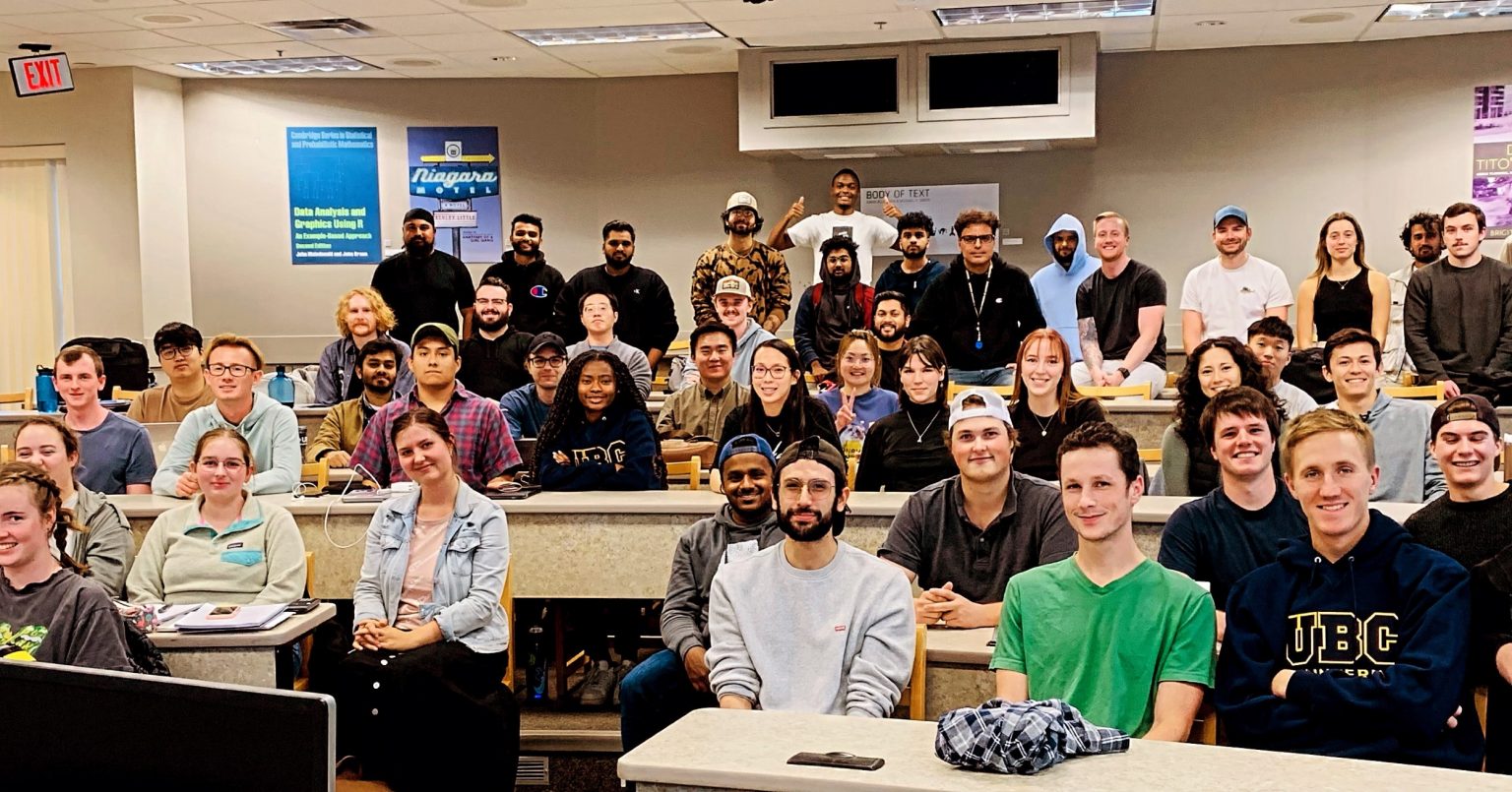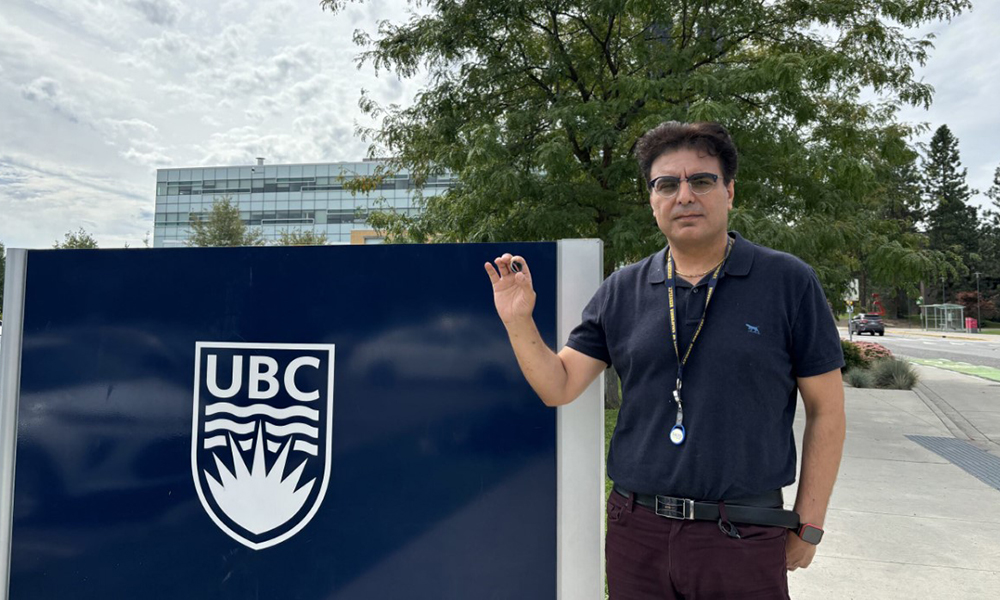
Dr. Hadi Mohammadi (back row) with engineering students at UBC Okanagan.
UBC Okanagan recently announced recipients of the 2024/25 Outstanding Instructor Award. Five faculty members from the School of Engineering were honoured with this prestigious award recognizing their exemplary teaching and notable dedication to student success.
Read our QandA with award recipient Dr. Hadi Mohammadi, Associate Professor, Biomedical and Mechanical Engineering to learn more about his teaching at UBCO. Way to go, Dr. Mohammadi!
About Dr. Hadi Mohammadi
Hadi Mohammadi was born and raised in Tehran, Iran. He began his postsecondary education at Sharif University of Technology, widely regarded as Iran’s leading engineering institution.
Who or what inspired you to study engineering?
Curiosity has always been the spark of discovery for me. From a young age, I pondered the world’s mysteries, how the heart beats with precision, how machines mimic nature, and how invention can ease suffering. Engineering, to me, is the bridge between imagination and reality. Driven by a desire to understand and improve how things work, I embraced the belief that “imagination is more important than knowledge,” as imagination reveals what could be.
My journey into biomedical engineering stems from merging science with compassion, creating devices that not only function elegantly but also bring comfort to those in need. Every heartbeat and tremor I seek to calm through my innovations represents a note in the symphony of human ingenuity.
Such inspiration, I believe, may not move mountains, but it can certainly improve a heart valve, or two.
How has engineering changed the way you view the world?
Engineering has transformed how I view the world, shifting my perspective from passive observation to active problem-solving. I now approach everyday challenges by analyzing systems, identifying inefficiencies, and seeking innovative solutions. My research in biomedical engineering has significantly deepened this mindset.

Dr. Hadi Mohammadi with the iValve.
Developing the iValve, a novel bileaflet mechanical heart valve, taught me to consider the complex interplay between mechanical design, fluid dynamics, and patient needs. It wasn’t just about creating a functional device; it was about improving patient outcomes and quality of life. Similarly, my work on a wearable device to dampen tremors in Parkinson’s patients has highlighted the importance of user-centered design and the potential of engineering to directly impact people’s daily experiences.
These projects have shown me that engineering is more than technical problem-solving, it’s about empathy, creativity, and responsibility. I’ve learned to see beyond the immediate problem, considering broader implications like accessibility, sustainability, and long-term usability. Whether analyzing a medical device or observing everyday objects, I now view the world as a network of systems that can be optimized to improve lives.
Engineering has instilled in me a continuous drive to innovate and use my skills to create solutions that matter.
You were recently named a recipient of UBCO’s 2024/25 Outstanding Instructor Award. Congratulations! What does this award mean to you?
 Receiving UBCO’s 2024/25 Outstanding Instructor Award is truly an honor and a humbling experience. Teaching has always been more than just a responsibility for me, it’s a passion and a privilege.
Receiving UBCO’s 2024/25 Outstanding Instructor Award is truly an honor and a humbling experience. Teaching has always been more than just a responsibility for me, it’s a passion and a privilege.
This award signifies recognition of my commitment to fostering an engaging, supportive, and innovative learning environment for my students. It also reflects the hard work and dedication of my students, colleagues, and mentors who continuously inspire me to improve.
Ultimately, this recognition reinforces my belief in the transformative power of education and motivates me to continue enhancing my teaching practices to better serve my students and the broader academic community.
What courses are you currently teaching?
I am currently teaching the following courses in the School of Engineering:
ENGR 387: Mechanical Vibrations
ENGR 482: Biomedical Engineering I
ENGR 492 & ENGR 582: Finite Element Method
ENGR 495: Tissue Engineering
These courses cover a range of topics, including vibration analysis, biomedical device design, computational modeling, and tissue engineering principles.
What is your teaching philosophy?
Ah, my dear friend, teaching is much like the universe, vast, intricate, and filled with wonder. My philosophy is simple yet profound: never stop questioning. Education should not be a mere transfer of facts; rather, it should ignite curiosity, encourage exploration, and inspire students to think beyond the boundaries of textbooks.
I believe that true understanding arises when one can see the beauty in complexity and distill it into simplicity.
You see, imagination is just as important as knowledge, for knowledge is limited to what we know, while imagination embraces the infinite possibilities of what we might discover. I strive to create an environment where students are not afraid to make mistakes, for, as I have found in my own work, mistakes are simply the stepping stones to deeper understanding.
In the end, I do not merely teach equations or theories, I encourage minds to dream, to ask why, and, more importantly, why not?
What do you hope students take away from your classes?
I hope my students leave my classes with more than just technical knowledge. I want them to develop critical thinking skills, a strong problem-solving mindset, and the confidence to tackle real-world engineering challenges. I aim to foster curiosity and a passion for continuous learning, encouraging them to question assumptions and seek innovative solutions. Beyond the technical aspects, I hope they appreciate the importance of teamwork, effective communication, and ethical responsibility in their professional journeys.
Most importantly, I want students to feel inspired and capable of making a meaningful impact through their work.
What drew you to UBC Okanagan’s School of Engineering?
What drew me to UBC Okanagan’s School of Engineering was its strong emphasis on interdisciplinary research, innovation, and community engagement. The collaborative environment and state-of-the-art facilities provided an ideal setting to pursue cutting-edge research in biomedical engineering, particularly in developing medical devices that address real-world health challenges.
I was also drawn to the opportunity to work closely with students in a smaller campus setting, fostering meaningful mentorship and creating a supportive learning environment. The Okanagan region’s vibrant community and quality of life further reinforced my decision, making it an inspiring place to teach, research, and contribute to impactful projects.
Anything else you’d like to share?
If there’s one thing I believe in wholeheartedly, it’s this: big ideas change the world.